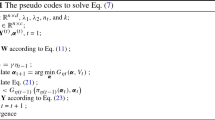Abstract
A clustering algorithm based on Sparse Projection (SP), called Sparse Projection Clustering (SPC), is proposed in this letter. The basic idea is applying SP to project the observed data onto a high-dimensional sparse space, which is a nonlinear mapping with an explicit form and the K-means clustering algorithm can be therefore used to explore the inherent data patterns in the new space. The proposed algorithm is applied to cluster a complete artificial dataset and an incomplete real dataset. In comparison with the kernel K-means clustering algorithm, the proposed algorithm is more efficient.
Similar content being viewed by others
References
T. Kanungo, D. Mount, N. Netanyahu, C. Piatko, et al. An efficient K-means clustering algorithm: Analysis and implementation. IEEE Transactions on Pattern Analysis and Machine Intelligence, 24(2000)7, 881–892.
R. Hathaway and J. Bezdek. Fuzzy c-means clustering of incomplete data. IEEE Transactions on Systems, Man, and Cybernetics-Part B: Cybernetics, 31(2001)5, 735–744.
S. Ridella, S. Rovetta, and R. Zunino. Plastic algorithm for adaptive vector quantization. Neural Computing and Applications, 7(1998)1, 37–51.
M. Girolami. Mercer kernel based clustering in feature space. IEEE Transactions on Neural Networks, 13(2002)3, 780–784.
P. O. Hoyer. Non-negative sparse coding. Proceedings of Neural Networks for Signal Processing, Martigny, Valais, Switzerland, Sept. 4–6, 2002, 557–565.
S. Li. Non-negative sparse coding shrinkage for image denoising using normal inverse Gaussian density model. Image and Vision Computing, 26(2008)1, 1137–1147.
A. Gersho and R. M. Gray. Vector Quantization and Signal Compression. Boston, Kluwer, 1991, 307–688.
Y. Linde, A. Buzo, and R. Gray. An algorithm for vector quantizer design. IEEE Transactions on Communications, 1(1980)1, 84–95.
S. J. Roberts, R. Everson, and I. Rezek. Maximum certainty data partitioning. Pattern Recognition, 33(2000)1, 833–839.
C. Merz and P. Murphy. UCI repository of machine learning databases. www.ics.uci.edu/mlearn/MLRepository. html, Jan. 1998.
B. Schukopf, A. J. Smola, and K. R. Muler. Nonlinear component analysis as a kernel eigenvalue problem. Neural Computation, 10(1998)5, 1299–1319.
Author information
Authors and Affiliations
Corresponding author
Additional information
Supported by the National Natural Science Foundation of China (No.60872123), the Joint Fund of the National Natural Science Foundation and the Guangdong Provincial Natural Science Foundation (No.U0835001).
Xie Zongbo, born in 19852, male, Ph.D. candidate.
Communication author: Feng Jiuchao, born in 1964, male, Professor.
About this article
Cite this article
Xie, Z., Feng, J. A sparse projection clustering algorithm. J. Electron.(China) 26, 549–551 (2009). https://doi.org/10.1007/s11767-008-0135-3
Received:
Revised:
Published:
Issue Date:
DOI: https://doi.org/10.1007/s11767-008-0135-3




